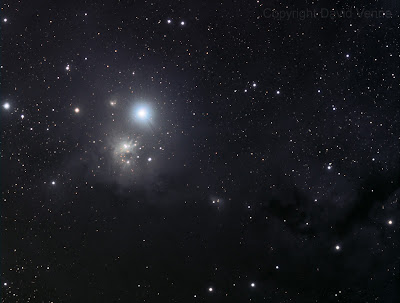- Cedar Hanson County Park near Trimont: Very nice for campers, but too many trees
- Sands Country Cove campground southwest of St. James: High density, packed even in April, which is not the nicest month to tour Minnesota. Reservations will be tight, just like how it packs the RVs together. It looks like it caters to families with big RVs. On the other hand, no trees.
- Eagle's Nest County Park east of St. James: Needs a variance to park away from trees in an open pasture that's probably dedicated to horse riders. I've written to the county parks person about that variance, but this is a "light green" light pollution area so not much darker than a local site.
- Voss Park, Butterfield: A large area of trees was removed and sites added since my last visit. It's also not much darker than a non-camping site I use now.
- Lake Hanska County Park, north of La Salle: Too many trees.
"In 2023, 45.5% of campers reported difficulty booking a site because a campground was sold out. It was four-times harder to find an available campsite to book than it was in 2019, when just 10.6% of campers reported difficulty."
Here is the realization: Campground reservations are a necessity. Sure, some campgrounds say they are first-come, first-serve. Theoretically you can see a good forecast in the morning, hop in the car and drive three hours to one of those campgrounds hoping there's an available spot for the night. But the chances are that spot will be gone by the time you get there, meaning you have to turn around and drive three hours back home. Not good. Minnesota state parks do allow same-day reservations, but your chance of that working in your favor seems particularly small if you want more than one consecutive night.
The Hunt for Darkness
What is Dark Enough, and What is Too Dark?
The diagram below shows an LPR diagram from the Light Pollution Atlas 2022 overlay. The area covered is from near the South Dakota border at left to a bit past Eau Claire WI at right, and just south of Duluth at top to Albert Lea at bottom. Color indicates LPR value with light green being between 0.6 and 1.0; dark green is 0.33 to 0.6. I've changed all areas with LPR greater than 3 to black.
Minnesota State Parks
Not suitable -- either too bright or blocked sky: Big Stone Lake, Blue Mounds, Camden, Flandrau, Fort Ridgely, Glacial Lakes, Kilen Woods (probably), Lake Maria, Minneopa, Minnesota Valley, Monson Lake, Myre Big Island, Sakatah Lake, Sibley, Split Rock Creek
Suitable: Lac qui Parle and Lake Shetek.
Lac qui Parle is a little darker than Lake Shetek but Montevideo to the southeast maye put up a light dome. One person who has been there said he did not note any problem with the horizon. The positions of these parks are indicated on the diagram above. Both parks can be found in its lower left corner.
Minnesota County Parks
Jackson County: Sandy Point (reservation required, choose site carefully to avoid trees, needs a visit to verify horizons)
Murray County: Sundquist, Lime, and Swenson (no reservations)
Lincoln County: Picnic Point and Norwegian Creek (reservations required)
Lyon County: Twin Lakes (reservations required)
Yellow Medicine County: Timm Park. Needs a visit to see which if any sites are suitable. (reservations required)
Counties that have no suitable county parks are Blue Earth, Brown, Chippewa, Cottonwood, Faribault, Freeborn, Kandiyohi, Martin, McLeod, Meeker, Mower, Nicollet, Nobles, Pipestone, Redwood, Renville, Rock, Sibley, Swift, Watonwan
Minnesota City and Town Parks
Many small cities and towns have parks that offer camping. These are generally near the population center and so will have considerable light pollution. I found none that were satisfactory for imaging.
Private Campgrounds
Camping on Private Lake. This was found on Hipcamp. It has an LPR of only 0.3! You would need to talk to the owner about being able to set up away from the trees. If you don't need AC power siting might be easier. Reservations required.
Camp Summit in Hadley. Seven sites, accepts reservations, but also allows space-available. LPR = 0.45Talking Waters in Gary, SD. Many sites, requires reservations. LPR = 0.51Niemackl Lake near Herman, MN. Accepts reservations by phone. LPR = 0.26. I visited this a few years ago and found maybe 3 or four of the 10 sites were decent. Neimackl has the distinction of being the darkest campground in my survey!There are a few places in northern Iowa that look very good, but they are generally about 3 hours distant and will be very busy.




